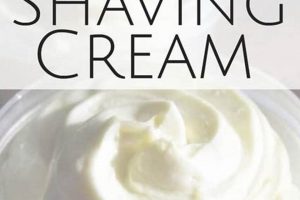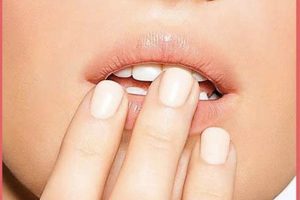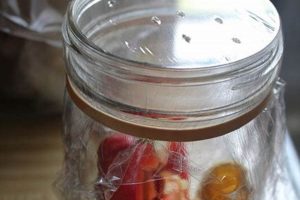The formulation of personalized bathing solutions, crafted from readily available household ingredients, offers a customizable alternative to commercially produced products. An example is a blend of liquid soap, glycerin, and essential oils to create a frothy bath experience.
This practice allows for control over ingredients, mitigating potential sensitivities to synthetic fragrances and harsh chemicals often found in mass-market offerings. Its appeal lies in the ability to tailor scents and additives to individual preferences and therapeutic needs, potentially offering aromatherapeutic and skin-soothing advantages. Historically, such preparations reflect a return to simpler, more natural self-care routines.
The subsequent sections will explore specific recipes, ingredient considerations, and best practices for achieving optimal results in the creation of these bespoke bathing experiences. Attention will also be given to safety precautions and storage recommendations.
Tips for Optimal Results with Homemade Bath Foaming Agents
Achieving a satisfying and effective bath foaming experience requires careful attention to formulation and technique. The following guidelines offer insights into maximizing the potential of these preparations.
Tip 1: Utilize a base of gentle, sulfate-free liquid soap. Harsh surfactants can cause skin irritation and negate the benefits of natural additives.
Tip 2: Incorporate vegetable glycerin to enhance bubble longevity and moisturizing properties. A ratio of one to two tablespoons per cup of liquid soap is generally recommended.
Tip 3: Introduce essential oils sparingly, selecting those known for their skin-safe qualities and therapeutic benefits. Dilution is critical; a few drops are typically sufficient.
Tip 4: Add distilled water to adjust the consistency and volume of the mixture. This also ensures a stable and homogenous product.
Tip 5: Introduce a small amount of honey to increase the viscosity and improve the stability of the foam.
Tip 6: When mixing ingredients, stir gently to avoid creating excessive foam prematurely. Over-agitation can reduce the final bubble yield in the bath.
Tip 7: Store the finished product in an airtight container in a cool, dark place to preserve its quality and prevent spoilage.
Tip 8: Test a small amount on a discrete area of skin before full use to ensure there is no allergic or irritating reaction to the solution.
Following these guidelines ensures a higher quality, more enjoyable, and potentially more beneficial bathing experience.
The concluding section will summarize the key advantages of creating personalized bath preparations and offer final recommendations for achieving consistently positive results.
1. Ingredients
The efficacy and safety of homemade bath formulations are intrinsically linked to the selection of constituents. The ingredients serve as the foundational elements, directly influencing the bathing product’s ability to generate foam, cleanse the skin, and deliver desired sensory experiences. For example, the choice between a coconut-derived surfactant and a conventional sodium lauryl sulfate has a direct effect on the potential for skin irritation; the former is generally recognized as milder. Similarly, the inclusion of honey acts as a natural humectant, attracting moisture to the skin during the bathing process, contrasting with a synthetic polymer designed for the same purpose but potentially carrying associated risks of impurities or allergic reactions. Ingredient quality thus dictates the overall outcome.
The practice of personalized bath creation also affords the opportunity to integrate botanical extracts and essential oils, tailoring the bathing experience to specific needs. Chamomile, for instance, is widely incorporated for its calming properties, promoting relaxation before sleep. Calendula-infused oil is favored for its potential anti-inflammatory benefits, addressing skin sensitivities. However, a thorough understanding of each component’s properties and potential interactions is paramount. Incorrect concentrations or incompatible combinations can lead to adverse reactions or diminished effectiveness. Essential oil dilutions should align with established aromatherapy guidelines, and potential allergens must be carefully considered.
In summary, the mindful selection of components is a critical determinant of a successful outcome. A comprehensive comprehension of ingredients’ properties, potential benefits, and associated risks is indispensable for generating a bath preparation that is both effective and safe. The value of personalized bath mixtures extends to understanding these interactions to create a quality product.
2. Formulation
Formulation is a critical aspect of crafting custom bath additives. It dictates the efficacy, aesthetics, and safety profile of the finished product, demanding careful consideration of ingredient ratios, mixing techniques, and final consistency.
- Surfactant Concentration
The proportion of surfactant, typically a liquid soap or similar cleansing agent, directly impacts foam generation and cleaning power. An insufficient concentration will yield inadequate foaming, while excessive amounts may lead to skin irritation. A 2:1 or 3:1 ratio of water to liquid soap is a common starting point but may require adjustment based on surfactant type and desired bubble density.
- Emollient Inclusion
Emollients, such as glycerin or carrier oils, contribute moisturizing properties and help stabilize the foam structure. Glycerin, in particular, attracts moisture to the skin and extends the lifespan of bubbles. Overuse can result in a greasy residue, while insufficient quantities may lead to dryness. Aiming for a small addition, approximately 1-2 tablespoons per cup of surfactant base, often achieves optimal balance.
- Viscosity Adjustment
The final viscosity influences both the pouring characteristics and the bubble consistency. Water is typically used to dilute the mixture to a desired consistency. Alternatively, thickeners, such as xanthan gum, can be added in minute amounts to increase viscosity and create a more luxurious feel. Accurate measurement and gradual incorporation are crucial to avoid clumping or over-thickening.
- pH Balance
The pH level affects skin compatibility and overall product stability. A pH that is too alkaline can be drying and irritating. A mildy acidic pH is generally better tolerated. Test strips or a pH meter can assess acidity and guide necessary adjustments using small amounts of citric acid or baking soda. Consistent results are important to preserve product integrity and mitigate adverse reactions.
These formulation factors underscore the importance of precise measurement and controlled experimentation in
the creation of a suitable bath additive. Fine-tuning each aspect ensures a balance between cleansing efficacy, skin hydration, and foam quality, ultimately influencing the bathing experience.
3. Safety
The preparation of homemade bath products necessitates a rigorous adherence to safety protocols. The direct contact with skin, combined with the potential for ingestion or inhalation of ingredients, underscores the importance of careful formulation and handling.
- Ingredient Selection and Allergen Awareness
The selection of ingredients must prioritize non-toxic and non-irritating substances. Natural ingredients, while often perceived as safer, can still pose allergenic risks. It is imperative to conduct thorough research on each ingredient’s potential allergenic properties and to perform patch tests prior to full-body application. Essential oils, in particular, require careful dilution to prevent sensitization or adverse reactions.
- Microbial Contamination and Preservation
Aqueous homemade preparations are susceptible to microbial growth. The absence of effective preservatives can lead to bacterial or fungal contamination, potentially causing skin infections or other health complications. While natural preservatives, such as vitamin E or grapefruit seed extract, may offer some protection, their efficacy is often limited. Proper sanitation of equipment and storage in airtight containers are essential to minimize contamination risks.
- pH Imbalance and Skin Irritation
The pH of the final product must be compatible with the skin’s natural pH (approximately 5.5). Highly alkaline or acidic formulations can disrupt the skin’s acid mantle, leading to dryness, irritation, or even chemical burns. Accurate pH measurement using pH strips or a pH meter is crucial, and adjustments should be made cautiously using appropriate buffering agents.
- Eye Irritation and Mucous Membrane Exposure
Bath products can come into contact with the eyes and mucous membranes, potentially causing irritation or discomfort. Ingredients known to be eye irritants, such as certain surfactants or essential oils, should be used sparingly or avoided altogether. In case of accidental eye exposure, immediate and thorough rinsing with water is essential.
A comprehensive understanding of potential hazards and the implementation of appropriate safety measures are indispensable for the safe creation and use of personalized bath products. Failure to prioritize safety can lead to adverse health outcomes, negating the potential benefits of a custom formulation.
4. Scent
The olfactory dimension significantly contributes to the therapeutic and sensory experience derived from customized bath preparations. The selection and integration of aromatic compounds offer considerable latitude in tailoring the bathing ritual.
- Essential Oil Selection and Therapeutic Intent
The choice of essential oils directly dictates the potential therapeutic effects. Lavender oil, for example, is commonly incorporated for its calming and sleep-promoting properties, while eucalyptus oil may be selected for its decongestant attributes. The concentration of these oils, however, must be carefully controlled to prevent skin irritation or adverse reactions. Dilution guidelines established by aromatherapy professionals should be strictly observed.
- Fragrance Oil Alternatives and Considerations
Fragrance oils offer an alternative to essential oils, providing a wider range of scent profiles and often at a lower cost. However, these synthetic compounds lack the therapeutic benefits associated with essential oils and may contain allergens or irritants. Transparency regarding the composition and potential risks associated with fragrance oils is paramount. Reputable suppliers should provide detailed safety data sheets.
- Scent Blending and Harmonious Composition
The art of blending aromatic compounds requires an understanding of scent families and their interactions. Certain scents complement each other, creating a harmonious and balanced olfactory experience, while others may clash, resulting in an unpleasant or overpowering aroma. Experimentation with small batches and careful record-keeping are essential for refining scent blends.
- Scent Longevity and Fixatives
The persistence of scent in the bathwater and on the skin is influenced by the volatility of the aromatic compounds. More volatile scents dissipate quickly, while heavier scents linger longer. Fixatives, such as carrier oils or certain resins, can be incorporated to prolong the scent’s lifespan. However, the use of fixatives should be approached cautiously, as they may alter the overall scent profile or introduce potential allergens.
The judicious integration of scent elevates the customized bath formulation beyond mere cleansing, transforming it into a holistic sensory experience. Careful consideration of scent selection, blending techniques, and potential risks is essential for achieving the desired therapeutic and aesthetic outcome.
5. Longevity
The extended usability of a bath preparation represents a crucial factor in its overall value and practicality. Preserving the integrity of ingredients, scent, and foaming capabilities directly impacts the product’s long-term effectiveness and consumer satisfaction.
- Ingredient Stability and Degradation
Certain components within homemade bath formulations exhibit susceptibility to degradation over time. Essential oils can oxidize, leading to altered scent profiles and reduced therapeutic benefits. Carrier oils may become rancid, impacting skin feel and potentially causing irritation. The selection of stable ingredients and the incorporation of antioxidants can mitigate these degradative processes, extending the product’s lifespan.
- Microbial Control and Preservation Methods
Aqueous bath preparations provide a conducive environment for microbial proliferation, leading to spoilage, altered appearance, and potential health risks. The inclusion of appropriate preservatives, whether natural or synthetic, is essential for inhibiting microbial growth and maintaining product safety. Proper sanitation of equipment and storage containers also contributes to minimizing microbial contamination.
- Packaging and Environmental Factors
Exposure to light, heat, and air can accelerate the degradation of bath formulation ingredients. Opaque, airtight containers stored in cool, dark environments offer optimal protection against these environmental factors. The choice of packaging material can also influence product longevity; certain plastics may interact with essential oils, leading to degradation or scent alteration.
- Scent Retention and Fixative Agents
The persistence of the desired fragrance directly influences the bathing experience. Volatile scent compounds dissipate quickly, requiring the incorporation of fixative agents to prolong the scent’s lifespan. However, fixatives can alter the overall scent profile and may introduce potential all
ergens. Careful selection and judicious use of fixatives are essential for achieving optimal scent retention without compromising product integrity.
Ultimately, maximizing the lifespan of homemade bath preparations requires a multifaceted approach that addresses ingredient stability, microbial control, environmental factors, and scent retention. Proactive measures taken during formulation and storage contribute to preserving product quality, ensuring a consistently satisfying and safe bathing experience.
6. Preservation
Microbial proliferation poses a significant challenge to the stability and safety of homemade bathing preparations. The aqueous nature of the product creates a conducive environment for the growth of bacteria, fungi, and mold, leading to spoilage, off-odors, and potential health risks. Inadequate preservation measures can render the product unusable within a short timeframe. For instance, a bath formulation lacking an effective preservative may exhibit visible mold growth within a week, particularly if stored in a humid environment. Consequently, an understanding of preservation techniques is paramount for ensuring the safety and longevity of these formulations. The effectiveness of preservation strategies directly dictates the practical utility of homemade solutions.
Effective preservation strategies encompass both ingredient selection and storage practices. The inclusion of natural or synthetic preservatives can inhibit microbial growth, extending the shelf life of the product. Examples of natural preservatives include vitamin E oil, grapefruit seed extract, and rosemary oleoresin extract, while synthetic options include phenoxyethanol and potassium sorbate. Additionally, proper sanitation of equipment, the use of airtight containers, and storage in a cool, dark location can minimize the risk of contamination. For example, using a sterilized mixing bowl and storing the finished product in a dark amber glass bottle can significantly reduce microbial growth compared to using a non-sterilized bowl and a clear plastic container. Furthermore, users can choose to create bubble bath for single use. It will completely remove preservation concern with proper care.
In conclusion, preservation is an indispensable component in the creation of safe and effective bathing additives. The absence of adequate preservation measures can compromise product integrity, leading to spoilage and potential health hazards. A multifaceted approach encompassing appropriate preservative selection, stringent sanitation practices, and optimized storage conditions is essential for maximizing the longevity and safety of homemade bathing preparations, thereby enhancing their practicality and value. Challenges persist in identifying effective natural preservatives that provide broad-spectrum protection without causing skin irritation or allergenic reactions. The ability to successfully overcome these challenges will significantly enhance the appeal and long-term viability of customizable bath formulations.
Frequently Asked Questions
The following addresses common inquiries regarding the composition, utilization, and safety considerations pertinent to bath foaming solutions.
Question 1: What constitutes an appropriate surfactant for inclusion in a bath foaming solution?
A gentle, sulfate-free liquid soap, such as cocamidopropyl betaine or decyl glucoside, is generally recommended to minimize skin irritation. Standard dish soaps are often too harsh and should be avoided.
Question 2: How can the longevity of the foam be extended?
The incorporation of glycerin, honey, or a small amount of sugar can enhance bubble stability. Additionally, avoiding excessive agitation during the bathwater filling process minimizes premature bubble collapse.
Question 3: Is the inclusion of essential oils safe?
Essential oils should be used with caution due to their concentrated nature and potential for skin sensitization. Dilution is paramount, typically a few drops per bath, and selection should prioritize oils known for their skin-safe properties. Perform a patch test before widespread use.
Question 4: What preservation methods are recommended?
Aqueous bath solutions are susceptible to microbial growth. While natural preservatives exist, their efficacy is limited. Proper sanitation of equipment, storage in airtight containers, and refrigeration can help extend shelf life. Consider making smaller batches for immediate use to minimize preservation concerns.
Question 5: Can food coloring be used for aesthetic purposes?
Food coloring can stain both the skin and the bathtub. Natural alternatives, such as beet juice powder or spirulina powder, may offer less intense coloration but pose a reduced risk of staining.
Question 6: What measures can be taken to prevent allergic reactions?
A thorough review of ingredient lists is essential to identify potential allergens. Perform a patch test on a small area of skin before full-body application. Discontinue use immediately if any signs of irritation or allergic reaction develop.
Careful ingredient selection, proper dilution, and diligent preservation practices are crucial for a safe and enjoyable experience. The above guidelines should assist the user in making the best decisions during creation of a bath foam additive.
The subsequent segment will offer a concise summary of the benefits associated with the crafting of personalized bath mixtures.
Concluding Remarks
“Diy bubble bath” formulations offer a customizable approach to personal care, providing control over ingredients and scent profiles. The creation of these bathing solutions necessitates a thorough understanding of surfactant properties, preservation techniques, and safety considerations to mitigate potential adverse effects. The benefits of tailor-made formulas extend to individuals with sensitive skin or specific fragrance preferences, though care must be taken to avoid harmful elements.
The ongoing pursuit of safer, more effective natural preservatives and surfactant alternatives will further enhance the appeal and viability of “diy bubble bath” practices. Continued research and adherence to established safety guidelines remain essential for promoting responsible formulation and preventing potential health risks associated with these personalized bathing products. Therefore, the future of DIY depends on a constant increase in public awareness and responsible application.







